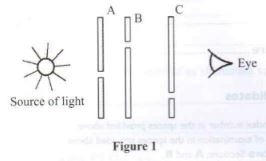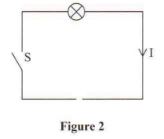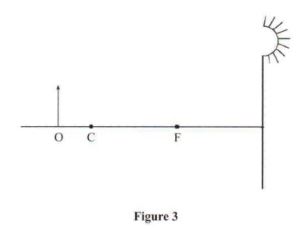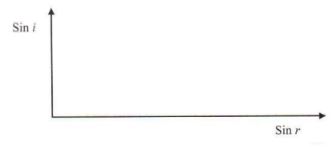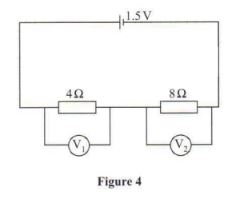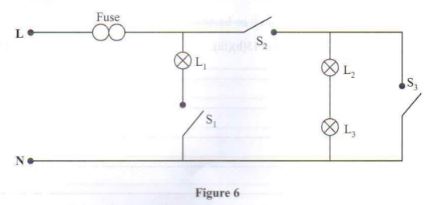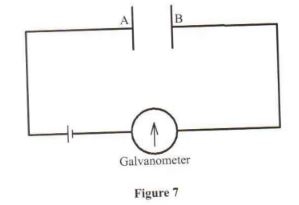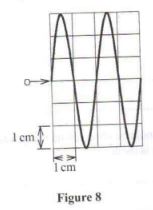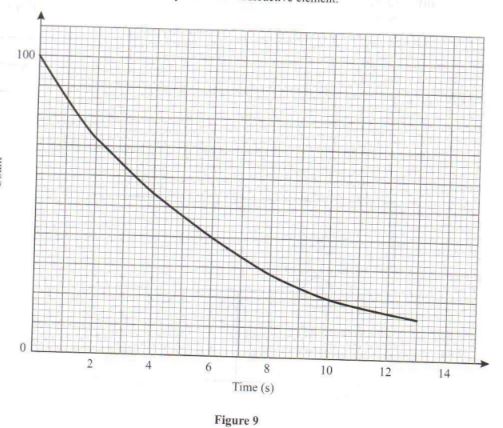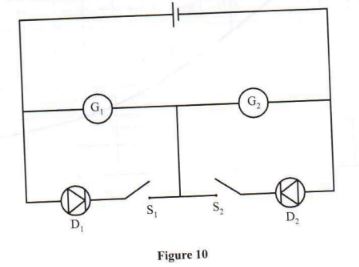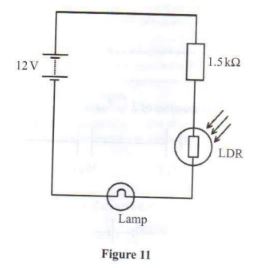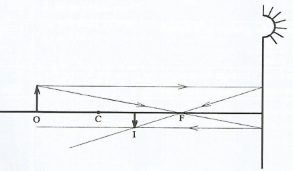SECTION A (25 marks)
Answer all the questions in this section in the spaces provided.
- Figure 1 shows three cardboards A, B and C with holes placed between a source of light and an observer.
Explain what is observed. (2 marks) - State how a polythene rod acquires a negative charge when it is rubbed by a piece of cloth. (1 mark)
- State one device that can be used to detect microwaves. (1 mark)
- Figure 2 shows an incomplete circuit.
Complete the circuit by inserting a cell so that the current I flows in the direction shown when the switch S is closed. (1 mark) - State the basic law of magnetism.(1 mark)
- Figure 3 shows a vertical object O placed in front of a concave mirror whose principal focus is at F.
Draw a ray diagram to show how the image is formed. (3 marks) - State two properties of soft iron that makes it suitable for use as the core of the electromagnet of an electric bell. (2 marks)
-
- State one reason why sound travels faster at sea level than on high mountains. (1 mark)
- State one condition necessary for two progressive waves to form a standing wave. (1 mark)
- Two students stand 300 m from a wall. One bangs two pieces of wood together and at the same time, the other starts a stop watch. They hear an echo after 1.8 seconds. Determine the speed of sound in air. (3 marks)
- During an experiment to investigate the relationship between the angle of incidence i, and angle of refraction r for a ray of light travelling from air to glass, the values of sin i and sin r were determined.
- On the axes provided, sketch the graph of sin i against sin r for the values that were obtained. (1 mark)
- State how the refractive index of the glass can be obtained from the graph. (1 mark)
- On the axes provided, sketch the graph of sin i against sin r for the values that were obtained. (1 mark)
- Figure 4 shows a circuit consisting of two resistors of 42 and 82, a cell and voltmeters V and V
It is observed that voltmeter V, shows a higher reading than V,. Explain this observation. (2 marks) - A heating element is rated 3kW, 240 V. Determine the resistance of the element. (3 marks)
- State two characteristics of images formed by diverging lenses. (2 marks)
SECTION B (55 marks)
Answer all the questions in this section in the spaces provided.
- State Lenz's law of electromagnetic induction. (1mark)
- Figure 5 shows a magnet held near a stationery solenoid.
State what will be observed on the galvanometer when the:- north pole end is pushed into the solenoid(1 mark)
- magnet is held stationary inside the solenoid (1 mark)
- north pole end is pulled out of the solenoid (1 mark)
- Explain what would be observed if the North pole of the magnet is now moved into the solenoid at a higher speed. (3 marks)
- State two causes of energy losses in a transformer. (2 marks)
- State the function of the ring main circuit in a domestic wiring system.(1 mark)
- Figure 6 shows a circuit consisting of switches S,, S., S, and three identical lamps L. L, and L, connected to the mains supply through a fuse.
- Identify two faults in the circuit. (2 marks)
- State the reasons for the answers in 15(b)(i). (2 marks)
- Describe how the brightness of lamps L, L, and L, compare when the switches S, and S, are closed. (2 marks)
- Explain the answer in 15(b)(iii). (2 marks)
- Figure 7 shows a circuit consisting of a cell in series with a galvanometer and two metal plates A and B.
- It is observed that when a beam of UV radiation falls on plate B, the galvanometer deflects. Explain this observation. (3 marks)
- Explain what would be observed on the galvanometer when a more intense beam of UV radiation is used. (2 marks)
- State with a reason how the intensity of an X-ray beam can be increased in an X-ray tube. (2 marks)
- Figure 8 shows the trace of an AC signal on the screen of a Cathode Ray Oscilloscope (CRO).
Given that the time base setting is 8.5 milliseconds per cm. Determine the:- wavelength of the AC signal (1 mark)
- frequency of the AC signal (3 marks)
- State the functions of the following parts of a Cathode Ray Oscilloscope:
- The grid (1 mark)
- The filament(1 mark)
- Figure 7 shows a circuit consisting of a cell in series with a galvanometer and two metal plates A and B.
- State one hazard of radioactivity.
- Figure 9 shows a decay curve of a radioactive element.
From the graph determine:- the half life of the element (1 mark)
- the number of half lives it will have undergone when the count is 12.5 (2 marks)
- State the effect of doping on a semiconductor. (1 mark)
- Explain how doping produces an n-type semiconductor from a pure semiconductor (3 marks)
- Figure 10 shows a circuit consisting of two galvanometers G, and G., two switches S, and S., a cell and two diodes D, and D..
Explain what is observed when S, and S, are closed. (4 marks)
- Explain the effect on resistance of a diode when the forward bias voltage is increased. (2 marks)
- Figure 11 shows a circuit consisting of a 12V battery, 1.5k resistor, a Light Dependent Resistor (LDR) and a lamp of negligible resistance. The circuit can be used as a light detector.
- Explain what would be observed if the lighting conditions are changed from total darkness to bright light. (3 marks)
- Ifi the resistance of the LDR in the bright is 1×10³Ω, determine the potenrial difference acrose 1.5 lΩ resistor (3marks)
Determine the total change storry by the capacitiot (3mark)
MARKING SCHEME
SECTION A
- The eye does not ✓ see the light since the holes are not ? in a straight line.
- The cloth loses some electrons ✓ to the polythene rod gains electrons from the clothe.
-
- Crystal detectors
- Aerial receiver
- Solid state diodes
- Radio receiver (any one)
-
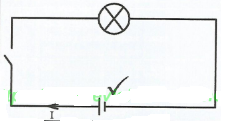
- Like poles repel while unlike poles attract✓
-
-
- Gives a stronger magnet (High concentration of magenetic flux) ✓
- Easily demagnetized/ magnetized ✓
-
- Air pressure/density is higher ✓ at sea level than on high moutnain.
-
- The waves should have the same amplitude.
- The waves should be out of phase
- Moving in opposite directions (any one)
- S = d/t ✓
= 2 × 300 ✓
1.8
= 333.3 m/s ✓ -
-
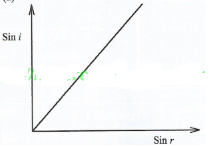
- By obtaining the gradient of the graph
n = Δ sin i
Δ sin r
-
- Same current flows ✓ through the resistors but given that V = IR, the higher the resistance, the higher the voltage.✓
- P = V2 ✓
R
= 2402 ✓
3000
= 19.2Ω ✓ -
- Upright✓
- Virtual ✓
- Diminished
- Always between lens and mprincipal focus (any two)
SECTION B
-
- The direction of the induced current is such that is opposes the change producing it. ✓
-
- Galvanometer deflects✓ momentarily
- There is no deflection ✓
- Galvanometer deflects in the opposite direction ✓
- More deflection ? due to more induced current ✓ because of the higher rate of change of flux)✓
-
- Hysteresis
- Eddy currents✓
- Heating effect/ copper losses
- Flux leakage (any two)
-
- Supplies current ✓ to the sockets.
-
-
- S1 is connected ✓ to the neutral
- S3 is not necessary✓
- L2 and L3 are in series
-
- Switch S1 should be ✓ in live wire (Lamp is still live even with the switch open)
- S3 will short ✓ circuit the mains supply.
- L2 and L3 should be connected in parallel.
-
- L1 is brighter than ✓ L2 and L3
- L2 and L3 have same ✓ brightness
- L1 is on full✓ voltage from the mains while L2 and L3 share the voltage from ✓ the mains.
-
-
-
-
- Uv dislodges electrons from plate B ✓
- Electrons are attracted to plate A connected✓ to the positive terminal of the cell.
- This causes the current to flow hence ✓ deflection.
- Galvanometer ✓ deflects more since more electrons are dislodged from plate B hence ✓ more current flows.
-
-
- Increasing the ✓ heater current this increases the production ✓ of electrons hence more x-rays
-
- λ = 1 × 2 = 2cm
- f = 1/T = 1 ✓
(8.5 × 10−3 × 2)
= 58.82Hz✓
-
- Grid:
- Controls the ✓ number of electrons reaching the screen.
- Controls brightness of the spot on the screen.
- Filament; Heats the ✓ cathode to produce electrons.
- Grid:
-
-
-
- Burning of skin ✓
- Causes of cancer (any one)
-
- Half life is 4.5s
- 3 half lives (Show working on graph)
-
- Improves the conductivity of the semi conductor
- Doping an intrinsic ✓ semiconductor with atoms of group V elements, four electrons will bond with the ✓ electrons of intrinsic semiconductor. The remaining ✓ electron is donated for conduction.
-
- Both G1 and G2 ✓ deflect but G2 has a greater deflection than G1 ✓
- D2 is reverse biased while D1 is forward ✓ biased hence conducts some of the main current ✓ but G2 carries the total current.
-
-
- Resistance ✓ decreases with increase in the applied voltage because the size of the depletion layer reduces ✓ allowing more current to flow.
-
-
- Initially the lamp does not light ✓ but when bright light falls on the LDR, the lamp lights. ✓
- When light falls on LDR, its resistance decreases hence current flows causing ✓ the lamp to light.
- RT = 1000 + 500 = 2500Ω ✓
IT = VT = 12 = 4.8 × 10−3A ✓
RT 2500
V = IR
= 1500 × 4.8 × 10−3
= 7.2V ✓
-
- Smoothens the output signal ✓
- Q = CV ✓
= 10 × 2.5 × 12 ✓
10 + 2.5
= 24μC ✓
Download PHYSICS Paper 2 Questions and Answers - KCSE 2022 Past Papers.
Tap Here to Download for 50/-
Get on WhatsApp for 50/-
Why download?
- ✔ To read offline at any time.
- ✔ To Print at your convenience
- ✔ Share Easily with Friends / Students

